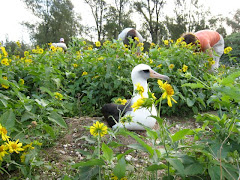Welcome to the PAA Blog
Papahānaumokuākea 'Ahahui Alaka'i (PAA) is a ten-day experiential leadership program that brings together teachers, business people, policy-makers as well as potential community leaders interested in learning and being inspired by science and traditional knowledge management practices. Papahānaumokuākea Marine National Monument encompasses roughly 140,000 square miles of the Pacific Ocean, an area larger than all the country's national parks combined. The area around the Northwestern Hawaiian Islands is an important safe haven for wildlife such as the threatened green turtle and the endangered Hawaiian monk seal. ‘Ahahu‘i refers to society, club or association. Alaka’i is Hawaiian for ambassador or leader. The Hawaiian word /acronym PA‘A means steadfast, learned, determined, strong, to hold, keep, retain.
Monday, June 8, 2009
Introductions: Karen Matsumoto deChadenedes
I hope to learn more about promoting stewardship and inspiring people to take positive actions and change behaviors toward environmental sustainability and humane communities. I want to learn by doing through the PAA experience and by sharing ideas with other educator-leaders in the program. I am excited about learning about traditional cultures of Hawaii, and how this traditional knowledge can help us to better understand how to inspire marine conservation in students and the general public. I also hope to learn more about the effects of global climate change and ocean acidification on long-term ecosystem health.
I would like to incorporate what I learn from the PAA experience into my education programs at Seattle Aquarium. My vision is to create a program that focuses on the connections between local ecosystems, objects, people, and cultural identity in the Pacific Rim, and to explore these links with young people. I would like to build connections between Pacific Rim communities (specifically between Coastal WA Tribal communities and Hawaiian communities) to help children connect with marine conservation through local ethnobotany and indigenous material culture, as well as to nurture global connections/exchange and real-life relationships.
I would like to incorporate what I learn from the PAA experience into my education programs at Seattle Aquarium. My vision is to create a program that focuses on the connections between local ecosystems, objects, people, and cultural identity in the Pacific Rim, and to explore these links with young people. I would like to build connections between Pacific Rim communities (specifically between Coastal WA Tribal communities and Hawaiian communities) to help children connect with marine conservation through local ethnobotany and indigenous material culture, as well as to nurture global connections/exchange and real-life relationships.
Subscribe to:
Post Comments (Atom)

















No comments:
Post a Comment